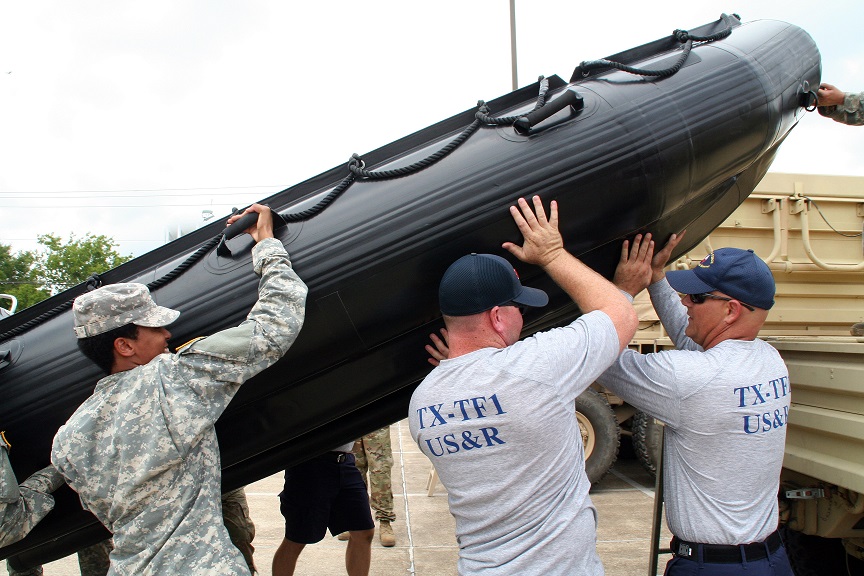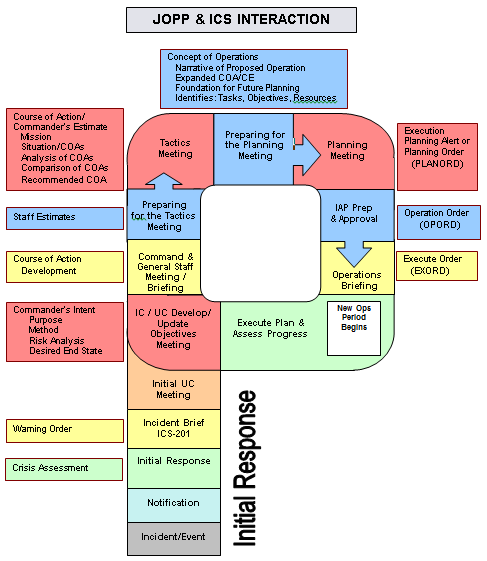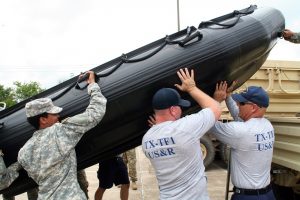
interoperability training leading up to Hurricane Harvey, in Bryan, August 25, 2017.
700 members of the Texas Army National Guard are being mobilized as part of Hurricane Harvey response operations.
(U.S. Army Photo by Sgt. Steve Johnson/Released)
Like many government agencies and private industries, emergency management has its own language. From “Incident Commanders” to “IAPs” to “Staging Areas”, we use an alphabet soup of acronyms and terms to define those commonalities that enable responders across a broad spectrum to understand what we mean when we request something like a ” Fire Truck – Aerial (Ladder or Platform)”.
In light of recent events in Texas where military units such as the National Guard are being deployed to assist, how does the emergency management field speak to the military? Although many branches are starting to more fully embrace the Incident Command System, the military still uses a planning process called APEX (formerly JOPES) or the Adaptive Planning and Execution.
APEX is a combination of joint policies and procedures and automated data processing (ADP) support used to plan and execute joint military operations. APEX is a system which translates the National Command Authority’s (President and Secretary of Defense) decisions into combatant commander’s joint operations. It includes:
• a set of publications and documents, which guide the development of deliberate plans (OPLANs) and operation orders (OPORDs),
• an operational planning process, which develops OPLANS and OPORDs, and
• an ADP support system, which provides the data processing support required for the development of OPLANs and OPORDs.
Under APEX, the Joint Operation Planning Process (JOPP) is the fundamental mechanism used by military planners at all levels to conduct detailed planning to fully develop options, identify resources, and identify and mitigate risk. The focus of JOPP is on the interaction between a military commander, staff, and commanders and staffs of the next higher and lower commands. Although the ultimate goal of JOPP is the completion of an operational plan or order, the process is ongoing as a unit must continually plan and produce operational plans, orders, and fragmentary orders for future operations and to make adjustments to current operations.
Outside of the military, civilian organizations are unlikely to see such OPLANs, as we wouldn’t want to broadcast how we will respond to a particular incident, such as a bomb threat. To compare how the military uses JOPP to what industry may use, think of your standing contingency plans. Many facilities have a host of contingency plans to cover spills, flooding, hurricanes, and more. Those pre-planned response activities are equivalent to the military’s Operations Plans (OPLANS) and are intended to be pulled off the shelf and rapidly put into action if such an incident were to occur (OPORD).
Recognizing that establishing a process is as important as planning, EMSI founder Chuck Mills says “What starts right, stays right”. It is critical that processes drive critical information and communication of that information to who it needs to go so decision makers have requisite information to affect response efforts. The time to design such processes is not when you have a response, but during your deliberate planning phases. To generalize the JOPP planning process, there are seven phases of planning:
• Planning Initiation – appropriate authority recognizes potential for military capability to be employed in response to a potential or actual crisis.
• Mission Analysis – an examination of the problem and purpose of the operation.
• Course of Action Development – A COA is a potential way (solution, method) to accomplish the assigned mission. The staff develops COAs to provide options to the commander, all oriented on accomplishing the military end state.
• COA Analysis and wargaming – COA analysis identifies advantages and disadvantages of each proposed friendly COA. Wargaming is a conscious attempt to visualize the flow of the operation, given joint force strengths and dispositions, adversary capabilities and possible COAs, the Operational Area, and other aspects of the operational environment.
• COA Comparison process – evaluates all COAs against established evaluation criteria and selects the COA that best accomplishes the mission.
• COA Approval
• Plan or Order Development – During plan or order development, the commander and staff, in collaboration with subordinate and supporting components and organizations, expand the approved COA into a detailed joint contingency plan or OPORD by first developing an executable CONOPS — the eventual centerpiece of the contingency plan or OPORD. This is the “blue print” for execution of the operation and all supporting plans.
 The Coast Guard’s JOPP and ICS Interaction diagram takes the linear process for producing JOPP OPLANS and Orders and bends it around the ICS Operational Planning “P”. Since the basic functional activities are essentially the same for all planning processes, this curvature works to explain both processes while showing the overlap and commonalities of JOPP and ICS functions, phases, and tools.
The Coast Guard’s JOPP and ICS Interaction diagram takes the linear process for producing JOPP OPLANS and Orders and bends it around the ICS Operational Planning “P”. Since the basic functional activities are essentially the same for all planning processes, this curvature works to explain both processes while showing the overlap and commonalities of JOPP and ICS functions, phases, and tools.
As incident management continues to evolve, we’re continuing to see the military use JOPP for its deliberate planning, but more frequently using ICS for Crisis Action Planning responses, particularly for those responses where they are integrating with other federal, state, and local agencies and private entities. The development of OPLANS and Contingency Plans better prepare both the government and industry for an incident, which can then be incorporated into the development of ICS Incident Action Plans when they respond. It’s important for both sides to recognize the need for a common language and processes to ensure that during an incident, everyone can communicate intent effectively and make sure the mission is safe and successful.
Since inception in 2000, EMSI has played a major role in helping government and industry clients alike, prepare, train, and respond to emergencies of any cause or size. Comprised of national and international all-risk, all-hazard response experts, EMSI’s seasoned cadre gives us a unique background and perspective in dealing with incident and responder needs at every level of government and industry, to include the international community. As a global response leader in all-risk, all-hazard, multi-discipline incidents, EMSI has a proven track record in helping the myriad of local, state, national, international, and private sector entities with their incident management and emergency management programs. EMSI is a service-disabled veteran owned small business (SDVOSB) and minority business enterprise (MBE) that supports a broad range of clients. To learn more about EMSI and how we can help your organization’s response preparedness, please visit www.emsics.com.


